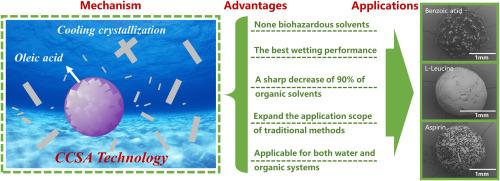Design of spherical agglomerates via crystallization with a non-toxic bridging liquid: From mechanism to application
Abstract
The cooling crystallization-spherical agglomeration (CCSA) technology proposed in this work overcomes the disadvantages of complex process and biohazardous solvents, which has broad application prospects in green and efficient granulation. CCSA selects oleic acid as a novel green and effective bridging liquid, and the results of droplet experiment and molecular simulation indicate that oleic acid presents the best wetting performance compared with the reported bridging liquids. Mechanistic studies demonstrate that oleic acid can induce spherical agglomeration during crystallization in a single solvent system, especially in water, reducing the dosage of organic solvent by about 90%, and fundamentally eliminating the toxicity of bridging liquid. The volume ratio of bridging liquid to solvent (RBS) and agitation are emphasized as the critical parameters tuning the particle size and sphericity. Further, the spherical agglomerates of benzoic acid, L-leucine and aspirin with controllable size and high sphericity were successfully prepared, which verifies the universality of CCSA.


 求助内容:
求助内容: 应助结果提醒方式:
应助结果提醒方式:


